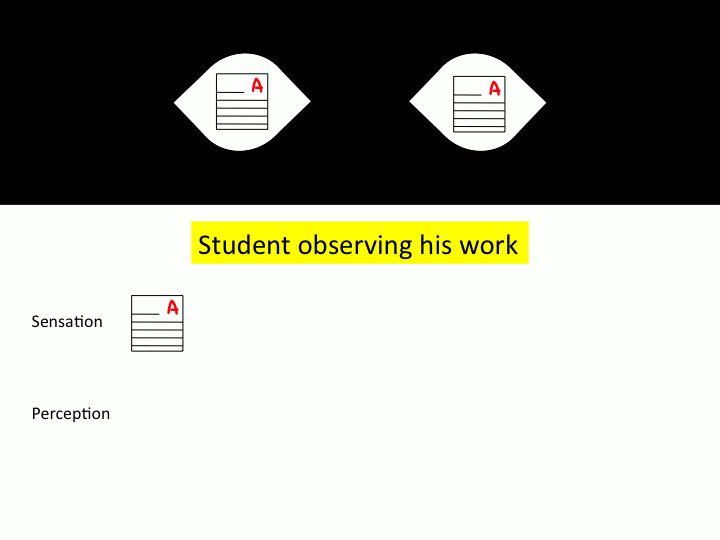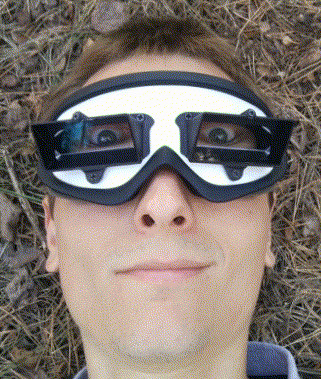|
Chronostasis
Chronostasis (from Greek χρόνος, chrónos, "time" and στάσις, stásis, "standing") is a type of temporal illusion in which the first impression following the introduction of a new event or task-demand to the brain can appear to be extended in time. For example, chronostasis temporarily occurs when fixating on a target stimulus, immediately following a saccade (i.e., quick eye movement). This elicits an overestimation in the temporal duration for which that target stimulus (i.e., postsaccadic stimulus) was perceived. This effect can extend apparent durations by up to half a second and is consistent with the idea that the visual system models events prior to perception. A common occurrence of this illusion is known as the stopped-clock illusion, where the second hand of an analog clock appears to stay still for longer than normal when looking at it for the first time. This illusion can also occur in the auditory and tactile domain. For instance, a study suggests that wh ... [...More Info...] [...Related Items...] OR: [Wikipedia] [Google] [Baidu] |
Time Perception
The study of time perception or chronoception is a field within psychology, cognitive linguistics and neuroscience that refers to the subjective experience, or sense, of time, which is measured by someone's own perception of the duration of the indefinite and unfolding of events. The perceived time interval between two successive events is referred to as perceived duration. Though directly experiencing or understanding another person's perception of time is not possible, perception can be objectively studied and inference, inferred through a number of scientific experiments. Some temporal illusions help to expose the underlying neural mechanisms of time perception. Pioneering work, emphasizing species-specific differences, was conducted by Karl Ernst von Baer. Theories Time perception is typically categorized in three distinct ranges, because different ranges of duration are processed in different areas of the brain: * Sub-second timing or millisecond timing * Interval timing o ... [...More Info...] [...Related Items...] OR: [Wikipedia] [Google] [Baidu] |
Saccade
A saccade ( , French for ''jerk'') is a quick, simultaneous movement of both eyes between two or more phases of fixation in the same direction.Cassin, B. and Solomon, S. ''Dictionary of Eye Terminology''. Gainesville, Florida: Triad Publishing Company, 1990. In contrast, in smooth pursuit movements, the eyes move smoothly instead of in jumps. The phenomenon can be associated with a shift in frequency of an emitted signal or a movement of a body part or device. Controlled cortically by the frontal eye fields (FEF), or subcortically by the superior colliculus, saccades serve as a mechanism for fixation, rapid eye movement, and the fast phase of optokinetic nystagmus. The word appears to have been coined in the 1880s by French ophthalmologist Émile Javal, who used a mirror on one side of a page to observe eye movement in silent reading, and found that it involves a succession of discontinuous individual movements. Function Humans and many animals do not look at a scene in f ... [...More Info...] [...Related Items...] OR: [Wikipedia] [Google] [Baidu] |
Greek Language
Greek ( el, label=Modern Greek, Ελληνικά, Elliniká, ; grc, Ἑλληνική, Hellēnikḗ) is an independent branch of the Indo-European family of languages, native to Greece, Cyprus, southern Italy (Calabria and Salento), southern Albania, and other regions of the Balkans, the Black Sea coast, Asia Minor, and the Eastern Mediterranean. It has the longest documented history of any Indo-European language, spanning at least 3,400 years of written records. Its writing system is the Greek alphabet, which has been used for approximately 2,800 years; previously, Greek was recorded in writing systems such as Linear B and the Cypriot syllabary. The alphabet arose from the Phoenician script and was in turn the basis of the Latin, Cyrillic, Armenian, Coptic, Gothic, and many other writing systems. The Greek language holds a very important place in the history of the Western world. Beginning with the epics of Homer, ancient Greek literature includes many works of lasting impo ... [...More Info...] [...Related Items...] OR: [Wikipedia] [Google] [Baidu] |
Measurement
Measurement is the quantification of attributes of an object or event, which can be used to compare with other objects or events. In other words, measurement is a process of determining how large or small a physical quantity is as compared to a basic reference quantity of the same kind. The scope and application of measurement are dependent on the context and discipline. In natural sciences and engineering, measurements do not apply to nominal properties of objects or events, which is consistent with the guidelines of the ''International vocabulary of metrology'' published by the International Bureau of Weights and Measures. However, in other fields such as statistics as well as the social and behavioural sciences, measurements can have multiple levels, which would include nominal, ordinal, interval and ratio scales. Measurement is a cornerstone of trade, science, technology and quantitative research in many disciplines. Historically, many measurement systems existed fo ... [...More Info...] [...Related Items...] OR: [Wikipedia] [Google] [Baidu] |
Perception
Perception () is the organization, identification, and interpretation of sensory information in order to represent and understand the presented information or environment. All perception involves signals that go through the nervous system, which in turn result from physical or chemical stimulation of the sensory system.Goldstein (2009) pp. 5–7 Vision involves light striking the retina of the eye; smell is mediated by odor molecules; and hearing involves pressure waves. Perception is not only the passive receipt of these signals, but it is also shaped by the recipient's learning, memory, expectation, and attention. Gregory, Richard. "Perception" in Gregory, Zangwill (1987) pp. 598–601. Sensory input is a process that transforms this low-level information to higher-level information (e.g., extracts shapes for object recognition). The process that follows connects a person's concepts and expectations (or knowledge), restorative and selective mechanisms (such as ... [...More Info...] [...Related Items...] OR: [Wikipedia] [Google] [Baidu] |
Illusions
An illusion is a distortion of the senses, which can reveal how the mind normally organizes and interprets sensory stimulation. Although illusions distort the human perception of reality, they are generally shared by most people. Illusions may occur with any of the human senses, but visual illusions (optical illusions) are the best-known and understood. The emphasis on visual illusions occurs because vision often dominates the other senses. For example, individuals watching a ventriloquist will perceive the voice is coming from the dummy since they are able to see the dummy mouth the words. Some illusions are based on general assumptions the brain makes during perception. These assumptions are made using organizational principles (e.g., Gestalt theory), an individual's capacity for depth perception and motion perception, and perceptual constancy. Other illusions occur because of biological sensory structures within the human body or conditions outside the body within one's physica ... [...More Info...] [...Related Items...] OR: [Wikipedia] [Google] [Baidu] |
Laci Green
Laci Green (born October 18, 1989) is an American YouTube personality, YouTuber. Her content focuses on sex education; Green also hosted ''Braless'', the first MTV YouTube channel, as part of a 12-week deal with MTV. The first episode aired November 4, 2014. In 2016, ''Time (magazine), Time'' named her one of the 30 most influential people on the Internet. In 2017, she celebrated her tenth anniversary on YouTube. Early life and education Green was born in Utah. Her mother is a Mormonism, Mormon from a small American town, and her father, from a Shia Muslim family, is from Iran. When she was two years old, her family moved to Portland, Oregon, and when she was twelve, they moved to California for her father's job. As she grew older she began to question the Mormon faith because of its strict gender roles and expectations of her as a woman. Growing up, Green was interested in theater and was supported by her mother, who owns a theater company. In 2011, Green graduated from the Uni ... [...More Info...] [...Related Items...] OR: [Wikipedia] [Google] [Baidu] |
Touch
In physiology, the somatosensory system is the network of neural structures in the brain and body that produce the perception of touch (haptic perception), as well as temperature (thermoception), body position (proprioception), and pain. It is a subset of the sensory nervous system, which also represents visual, auditory, olfactory, and gustatory stimuli. Somatosensation begins when mechano- and thermosensitive structures in the skin or internal organs sense physical stimuli such as pressure on the skin (see mechanotransduction, nociception). Activation of these structures, or receptors, leads to activation of peripheral sensory neurons that convey signals to the spinal cord as patterns of action potentials. Sensory information is then processed locally in the spinal cord to drive reflexes, and is also conveyed to the brain for conscious perception of touch and proprioception. Note, somatosensory information from the face and head enters the brain through peripheral senso ... [...More Info...] [...Related Items...] OR: [Wikipedia] [Google] [Baidu] |
Auditory System
The auditory system is the sensory system for the sense of hearing. It includes both the sensory organs (the ears) and the auditory parts of the sensory system. System overview The outer ear funnels sound vibrations to the eardrum, increasing the sound pressure in the middle frequency range. The middle-ear ossicles further amplify the vibration pressure roughly 20 times. The base of the stapes couples vibrations into the cochlea via the oval window, which vibrates the perilymph liquid (present throughout the inner ear) and causes the round window to bulb out as the oval window bulges in. Vestibular and tympanic ducts are filled with perilymph, and the smaller cochlear duct between them is filled with endolymph, a fluid with a very different ion concentration and voltage. Vestibular duct perilymph vibrations bend organ of Corti outer cells (4 lines) causing prestin to be released in cell tips. This causes the cells to be chemically elongated and shrunk ( somatic motor), and ... [...More Info...] [...Related Items...] OR: [Wikipedia] [Google] [Baidu] |
Neural Adaptation
Neural adaptation or sensory adaptation is a gradual decrease over time in the responsiveness of the sensory system to a constant stimulus. It is usually experienced as a change in the stimulus. For example, if a hand is rested on a table, the table's surface is immediately felt against the skin. Subsequently, however, the sensation of the table surface against the skin gradually diminishes until it is virtually unnoticeable. The sensory neurons that initially respond are no longer stimulated to respond; this is an example of neural adaptation. All sensory and neural systems have a form of adaptation to constantly detect changes in the environment. Neural receptor cells that process and receive stimulation go through constant changes for mammals and other living organisms to sense vital changes in their environment. Some key players in several neural systems include Ca2+ions (see Calcium in biology) that send negative feedback in second messenger pathways that allow the neural recep ... [...More Info...] [...Related Items...] OR: [Wikipedia] [Google] [Baidu] |
Attention
Attention is the behavioral and cognitive process of selectively concentrating on a discrete aspect of information, whether considered subjective or objective, while ignoring other perceivable information. William James (1890) wrote that "Attention is the taking possession by the mind, in clear and vivid form, of one out of what seem several simultaneously possible objects or trains of thought. Focalization, concentration, of consciousness are of its essence." Attention has also been described as the allocation of limited cognitive processing resources. Attention is manifested by an attentional bottleneck, in terms of the amount of data the brain can process each second; for example, in human vision, only less than 1% of the visual input data (at around one megabyte per second) can enter the bottleneck, leading to inattentional blindness. Attention remains a crucial area of investigation within education, psychology, neuroscience, cognitive neuroscience, and neuropsychology. ... [...More Info...] [...Related Items...] OR: [Wikipedia] [Google] [Baidu] |






